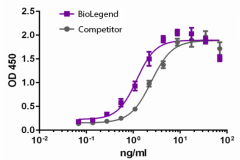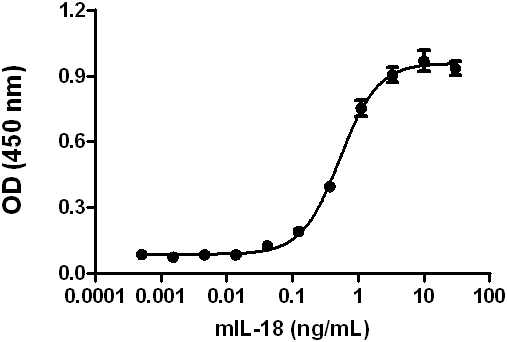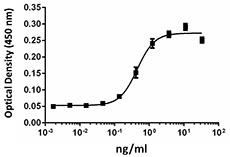- Regulatory Status
- RUO
- Other Names
- Interleukin 1 family, member 9 (IL-1F9), IL-1F, IL-1ε, IL-1H1
- Ave. Rating
- Submit a Review
- Product Citations
- publications

-

Mouse IL-36γ induces IL-6 secretion in 3T3L1 preadipocytes, in a dose-dependent manner. BioLegend’s Mouse IL-36γ product was compared side-by-side to the leading competitor’s equivalent product.
The IL-1 family is a group of cytokines comprised of 11 members, including the recently renamed IL-36 cytokines, IL-36α, β, and γ (previously known as IL-1F6, IL-1F8, and IL-1F9, respectively). IL-36γ signals through the IL-1 receptor family members IL-1Rrp2 and IL-1RAcP and can activate downstream MAP kinases and transcription factor NF-κB. IL-36γ is synthesized without signal peptide and the secretion pathway is unclear. It has been shown that like other IL-36 cytokines, the N-terminal processing of IL-36γ can significantly increase its biological activity. The possible processing enzymes are currently unknown. IL-36γ plays a significant role in the immune response, as low levels of IL-36 receptor IL-1Rrp can be detected on bone marrow-derived dendritic cells and CD4+ T cells. IL-36γ treatment can upregulate CD80, CD86 and MHC Class II, and proinflammatory cytokine production in dendritic cells. IL-36γ has also been implicated in airway hyperesponsiveness. Intranasal administration of recombinant IL-36γ in mice leads to epithelial cell hypertrophy, cellular infiltration, and mucus production. IL-36γ expression in the lungs of mice can be upregulated by allergic inflammation. In the skin, IL-36γ is primarily expressed by keratinocytes and its expression can be upregulated by inflammatory cytokines, toll-like receptor ligands, and some pathological conditions. IL-36γ is highly induced in psoriasis plaques.
Product DetailsProduct Details
- Source
- Mouse IL-36γ, amino acids Gly13-Ser164 (Accession# Q8R460), was expressed in E. coli.
- Molecular Mass
- The 152 amino acid recombinant protein has a predicted molecular mass of approximately 20 kD. The DTT-reduced and non-reduced protein migrates at approximately 20 kD by SDS-PAGE. The predicted N-terminal amino acid is Gly.
- Purity
- >95%, as determined by Coomassie stained SDS-PAGE.
- Formulation
- 0.22 µm filtered protein solution is in 20 mM MOPS, pH 7.4, 150 mM NaCl, 10 mM TCEP.
- Endotoxin Level
- Less than 0.01 ng per µg cytokine as determined by the LAL method.
- Concentration
- 10 and 25 µg sizes are bottled at 200 µg/mL. 100 µg size and larger sizes are lot-specific and bottled at the concentration indicated on the vial. To obtain lot-specific concentration and expiration, please enter the lot number in our Certificate of Analysis online tool.
- Storage & Handling
- Unopened vial can be stored between 2°C and 8°C for up to 2 weeks, at -20°C for up to six months, or at -70°C or colder until the expiration date. For maximum results, quick spin vial prior to opening. The protein can be aliquoted and stored at -20°C or colder. Stock solutions can also be prepared at 50 - 100 µg/mL in appropriate sterile buffer, carrier protein such as 0.2 - 1% BSA or HSA can be added when preparing the stock solution. Aliquots can be stored between 2°C and 8°C for up to one week and stored at -20°C or colder for up to 3 months. Avoid repeated freeze/thaw cycles.
- Activity
- The ED50 is 1 - 5 ng/ml, corresponding to a specific activity of 0.2 - 1.0 x 106 units/mg, as determined by a dose-dependent stimulation of IL-6 secretion in 3T3L1 preadipocytes.
- Application
-
Bioassay
- Application Notes
-
BioLegend carrier-free recombinant proteins provided in liquid format are shipped on blue-ice. Our comparison testing data indicates that when handled and stored as recommended, the liquid format has equal or better stability and shelf-life compared to commercially available lyophilized proteins after reconstitution. Our liquid proteins are verified in-house to maintain activity after shipping on blue ice and are backed by our 100% satisfaction guarantee. If you have any concerns, contact us at tech@biolegend.com.
- Product Citations
-
Antigen Details
- Structure
- IL-1 family cytokine.
- Distribution
-
Peripheral blood lymphocytes, keratinocytes, bronchial epithelial cells.
- Function
- IL-36γ is a proinflammatory cytokine. It is upregulated by inflammatory cytokines, toll-like receptor ligands, and some pathological conditions in skin. Truncation of IL-36α, IL-36β, and IL-36γ enhances their activity.
- Interaction
- Dendritic cells, macrophages, lung fibroblasts.
- Ligand/Receptor
- A combination of IL-1Rrp2 and IL-1RAcP.
- Biology Area
- Angiogenesis, Cell Biology, Immunology, Innate Immunity, Signal Transduction
- Molecular Family
- Cytokines/Chemokines
- Antigen References
-
1. Blumberg H, et al. 2007. J. Exp. Med. 204:2603.
2. Vigne S, et al. 2011. Blood. 118: 5813.
3. Ramadas RA, et al. 2006. Immunogenetics. 58:851.
4. Carrier Y, et al. 2011. J. Invest. Dermatol. 131:2428.
5. Debets R, et al. 2001. J. Immunol. 167:1440.
6. Towne J, et al. 2004. J. Biol. Chem. 279:13677.
7. Towne J, et al. 2011. J. Biol. Chem. 286:42594. - Gene ID
- 215257 View all products for this Gene ID
- UniProt
- View information about IL-36gamma on UniProt.org
Related Pages & Pathways
Pages
Related FAQs
- Why choose BioLegend recombinant proteins?
-
• Each lot of product is quality-tested for bioactivity as indicated on the data sheet.
• Greater than 95% Purity or higher, tested on every lot of product.
• 100% Satisfaction Guarantee for quality performance, stability, and consistency.
• Ready-to-use liquid format saves time and reduces challenges associated with reconstitution.
• Bulk and customization available. Contact us.
• Learn more about our Recombinant Proteins. - How does the activity of your recombinant proteins compare to competitors?
-
We quality control each and every lot of recombinant protein. Not only do we check its bioactivity, but we also compare it against other commercially available recombinant proteins. We make sure each recombinant protein’s activity is at least as good as or better than the competition’s. In order to provide you with the best possible product, we ensure that our testing process is rigorous and thorough. If you’re curious and eager to make the switch to BioLegend recombinants, contact your sales representative today!
- What is the specific activity or ED50 of my recombinant protein?
-
The specific activity range of the protein is indicated on the product datasheets. Because the exact activity values on a per unit basis can largely fluctuate depending on a number of factors, including the nature of the assay, cell density, age of cells/passage number, culture media used, and end user technique, the specific activity is best defined as a range and we guarantee the specific activity of all our lots will be within the range indicated on the datasheet. Please note this only applies to recombinants labeled for use in bioassays. ELISA standard recombinant proteins are not recommended for bioassay usage as they are not tested for these applications.
- Have your recombinants been tested for stability?
-
Our testing shows that the recombinant proteins are able to withstand room temperature for a week without losing activity. In addition the recombinant proteins were also found to withstand four cycles of freeze and thaw without losing activity.
- Does specific activity of a recombinant protein vary between lots?
-
Specific activity will vary for each lot and for the type of experiment that is done to validate it, but all passed lots will have activity within the established ED50 range for the product and we guarantee that our products will have lot-to-lot consistency. Please conduct an experiment-specific validation to find the optimal ED50 for your system.
- How do you convert activity as an ED50 in ng/ml to a specific activity in Units/mg?
-
Use formula Specific activity (Units/mg) = 10^6/ ED50 (ng/mL)
 Login / Register
Login / Register 














Follow Us